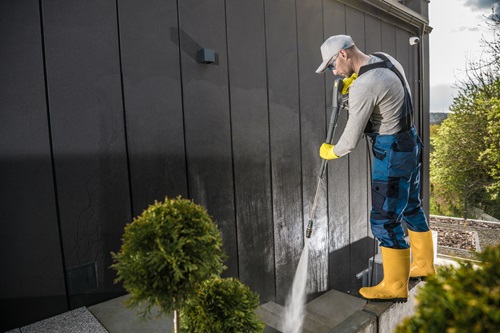
Pressure washing holds the potential to transform the appearance of your home, effectively removing dirt, mold, and grime from various surfaces. However, it’s not as simple as just pointing and spraying. To ensure optimal results and avoid costly mistakes, it’s essential to understand the nuances of pressure washing.
Whether you’re a seasoned DIY enthusiast or new to the world of home maintenance, this guide will equip you with the knowledge needed to master the art of pressure washing.
Introduction to the Power of Pressure Washing
First, pressure washing employs a high-pressure water spray to cleanse surfaces such as patios, decks, driveways, sidewalks, and exterior walls. While it can deliver remarkable outcomes, it requires caution and expertise. And, misusing a pressure washer can lead to damage or injury, emphasizing the importance of understanding common pitfalls and how to sidestep them.
Grasping the Fundamentals of Pressure Washing
Before embarking on a power washing venture, it’s crucial to understand the mechanics. Remember, a pressure washer operates by utilizing a motor-driven pump to propel water through a concentrated nozzle, generating a forceful stream. And, adjusting the water pressure and nozzle type according to the cleaning task is key to achieving desired results.
Taking Pressure Washing Lightly
Underestimating the complexity of power washing is a prevalent mistake. While pressure washers may seem straightforward, they demand respect due to their power and potential hazards. Additionally, proper preparation and understanding of equipment usage are imperative to prevent accidents.
Attempting to Pressure Wash Everything
Furthermore, not all surfaces are suitable for pressure washing, and indiscriminate use can lead to damage. Softwood, painted surfaces, and delicate materials require careful handling to avoid harm. So, prioritize understanding surface compatibility to prevent costly mishaps.
Disregarding the User Manual
The user manual is a valuable resource often overlooked. And, it provides essential instructions on operating the pressure washer safely and effectively. Ignoring this guidance increases the risk of misuse and potential damage to property or individuals.
 The Dangers of Using Excessive Pressure
The Dangers of Using Excessive Pressure
High-pressure washing can wreak havoc on delicate surfaces, leading to irreversible damage. From brick to softwood, inappropriate pressure levels can result in unnecessary repair expenses. Initiating cleaning at lower pressures and adjusting as needed is vital to safeguarding surfaces.
Tailoring Pressure Levels for Different Surfaces
Each surface demands a specific pressure level for optimal cleaning. Concrete may tolerate higher pressures, whereas wood requires gentler treatment. Familiarizing yourself with these nuances and adjusting your equipment accordingly ensures effective and safe cleaning.
The Significance of Correct Pressure Washing Technique
Effective power washing extends beyond pressure levels; technique plays a pivotal role. Improper angles, inconsistent movements, or neglecting to start from the bottom can yield subpar results or even damage surfaces.
Tips for Enhancing Your Technique
Adopting a downward angle, maintaining consistent movement, and starting from the bottom up are fundamental techniques for successful pressure washing. Practice and patience are key to mastering these skills and achieving optimal outcomes.
Essential Safety Measures
Operating a pressure washer requires adherence to strict safety protocols. Protective gear, securing the work area, and avoid pointing the nozzle at people or fragile objects are non-negotiable precautions.
Consequences of Ignoring Safety Protocols
Failure to observe safety measures can result in severe injuries or property damage. High-pressure water can cause lacerations, while loose debris poses projectile hazards. Additionally, using a pressure washer on unstable surfaces can lead to falls or accidents.
Choosing Compatible Cleaning Agents
Moreover, not all cleaning agents are suitable for pressure washing. Improper chemicals can damage equipment and pose environmental risks. Opting for detergents specifically formulated for pressure washers ensures safe and effective cleaning.
The Value of Regular Maintenance
Meanwhile, proper maintenance is essential for preserving the longevity and performance of your pressure washer. Regular inspections, component replacements, and cleaning are integral to preventing malfunctions and ensuring consistent operation.
Recognizing Maintenance Indicators
Also, signs such as decreased pressure, leaks, or inconsistent spraying indicate the need for maintenance. And, addressing these issues promptly extends the lifespan of your equipment and maintains optimal functionality.
Elevating Your Pressure Washing Proficiency
So, mastering pressure washing is a multifaceted endeavor that requires attention to detail, technique refinement, and safety consciousness. By understanding common pitfalls and implementing best practices, you can elevate your experience to new heights. Remember, safety should always be a priority, and when in doubt, seek professional guidance.
Ready to embark on your pressure washing journey? Then, equip yourself with the knowledge and tools needed for success. Whether you’re revitalizing your home’s exterior or tackling tough stains, prioritize safety and precision. Maximize your experience and unlock the full potential of your property’s cleanliness and curb appeal.
With these insights, you’re poised to become a pressure washing pro. Happy cleaning! Call K&M Pressure Washing LLC now if you need the help of an expert.
Like our Facebook page for more great info.

No comments:
Post a Comment